
A pool pump is the heart of any swimming pool, playing a crucial role in circulating and filtering water to maintain cleanliness and clarity. Understanding the significance of a pool pump is essential for every pool owner, but equally important is recognizing the potential threats that can compromise its efficiency. Various factors, if not carefully managed, can lead to the destruction or damage of pool pumps.
Let’s delve into the potential hazards that could compromise your pool pump’s functionality and essential tips on ways to safeguard it.
1. Frozen Pool Pump

Problem: Water expands 9% when it turns into ice, and this can rupture a pool pump volute or strainer housing, causing cracks that require part replacement.
Solution: Keep the pump running during cold temperatures. As long as water is moving through the pipes, nothing will freeze. If it is not possible to run the pump, remove both pump drain plugs (and filter plugs, heater plugs, chlorinator, etc.). With freeze protection for pool equipment, a pool controller or a digital time clock can use a freeze sensor, which will turn on the pump automatically.
2. Flooded Pool Pump
Problem: When motors are submerged underwater, drowning is usually fatal. Occasionally a partially submerged motor will survive, if taken apart and dried internally, unless it was running at the time of the flooding! Many pumps start out their lives well above the ground, but over years, sediment and debris can raise the ground until there is very little clearance.
Solution: Raise the pump, or lower the ground! Be sure that the area around your pool equipment drains rapidly during heavy rains. If flood waters threaten your pool pump, sand bag the pad, or remove the pump to higher ground until waters recede. If water no longer runs away from the equipment quickly, dig out any in-fill or soils that have washed up against the pad, grading slopes and swales to carry water away. Add gravel around the pump and filter area to reduce moisture and slow weed growth.
3. Dry Pool Pump
Problem: Pumps that ‘run dry’ (without incoming water) for long periods can blow out the shaft seal and begin leaking. In some cases, it will melt pump baskets and even deform the pump volute. Resulting high temps also will shrink the threads on PVC fittings threaded in/out of the pump, causing air leaks on the inlet side, and water leaks around the outlet pipe fitting.
Solution: Maintaining a proper water level in the pool is the first advice. Secondly, hunt down and fix any air leaks on the incoming pipes or suction cleaner hoses, which can cause the pump to lose prime. Finally, be sure that the pump lid is lubed and tight, and drain plugs are Teflon taped and tight. The other common air leak is around melted and shrunk PVC fittings threaded into the pump, as mentioned above. Replace the shrunken fitting, or make a patch with Pool Putty.
4. Wet Pool Pump
Problem: Bushes, weeds and overhanging trees trap moisture and restrict air flow around pool pumps. Soil and mulch around pumps and low areas trap water and moisture. Pump motors will last longer in dry conditions.
Solution: Trim bushes and plants as needed to reduce moisture and increase air flow. Use gravel and remove or spray weeds regularly, to keep the pump area a plant-free zone.
5. Hot Pool Pump

Problem: Motors need good air circulation to stay cool while running, which also helps a pool motor last longer. Plants, mulch or enclosed spaces block the breeze. Direct sun will also raise motor temperature.
Solution: Motors are always hot to the touch, running at around 140 degrees. Good air circulation reduces motor temps. Pump motor shields can be used to block sunlight.
6. Wrong Size Pump
Problem: Pumps that are too big for the pipe size or number of incoming pipes will cavitate under excessive vacuum pressure, essentially starved for water. And pool pumps that are too small for the system will struggle against a heavy resistance pressure. In both cases, the pump and motor is overworked; a leading cause of heart (pump) failure.
Solution: Select new pool pumps based on a careful consultation of the Pump Flow Curve, with a good estimate of your system resistance, and the knowledge of your Filter Design Flow Rate. Replacing with the exact duplicate pump is a good bet, or an IntelliFlo or EcoStar variable speed pump can be optimized to match system resistance.
7. Wrong Pump Wiring
Problem: Incorrect voltage, wire size or wiring. High or low voltage over time can stress the motor, or just flat burn it out, causing a short across the windings or blowing out the capacitor repeatedly. Pool motors are available in 120V and 240V (only), and also 120V/240V, known as reversible motors, able to accept either voltage. Connecting 120V into a motor that is expecting 240V just won’t start the motor, but putting 240V into a motor wired for 120V and you can expect sparks and smoke and a dead motor if not shut off quickly! Mis-wired motors, or using incorrect wire size could also cause motor problems.
Solution: Line voltage should be stable and within 10% of 115V or 230V, whichever is used. When installing a new motor, double check that line voltage matches motor voltage. Read the wiring diagram closely on the motor label to be sure that your power leads and ground wire are correctly attached to the terminal board. Although modern motors are fairly straight-forward with the power connection, it is possible to mis-wire a motor. And, if replacing old wires, be sure to use the correct wire size, usually 12/3, or 12 AWG size, three wires, usually white, black and green.
8. Insect Infestation

Problem: Insects can chew through wires or can short out circuitry as they seek the warmth and shelter of the pump motor, becoming a conductor between two metals that should not touch. This can happen in the rear of the pump motor, or in the time clock or control panel. Wasp or hornets nests can also make a mess.
Solution: Use insecticide as needed. Seal up any open knock-outs, and block any other access points to control panels and motors.
9. Heavy Mulch
Problem: Mulch is very acidic and traps moisture, creating an acrid humid air around the pump motor, which can be corrosive to metallic pump parts. And when each spring another 2″ of mulch is laid down, over time this raises the ground level, reducing air flow and in some cases increasing the chances of flooding the pool pump.
Solution: Use gravel, not mulch around your pool equipment. Use a rake or leaf blower regularly to remove sticks, leaves or ‘natural mulch’.
10. Heavy Snow

Problem: Pool pumps under a pile of snow cannot breathe. Moisture becomes trapped inside the motor when there is no air circulation. Repeated freeze/thaw cycles creates internal rust between the stator and rotor, causing motors to ‘lock-up’ come spring. Avoid extended periods of heavy snow; small amounts pose little concern.
Solution: Use an upside down Rubbermaid container, or laundry basket to cover the pump, cut out on side to fit snugly over the pump and/or motor. Be sure to allow for sufficient air flow on all sides, so as not to trap moisture inside. For the same reason, never wrap a motor tightly in plastic. An even better method is to install pool pump unions for easy winter removal, and indoor storage.
11. Heavy Branches

Problem: Heavy branches that fall, just right across a pool pump motor or on top of the pump lid, can do considerable damage to pool pumps. Not often, but it happens occasionally.
Solution: Trim branches as needed.
Good pool pump maintenance ensures a healthy heart for your pool circulation system and prevents premature “heart failure,” which can happen during the hottest week of the summer.

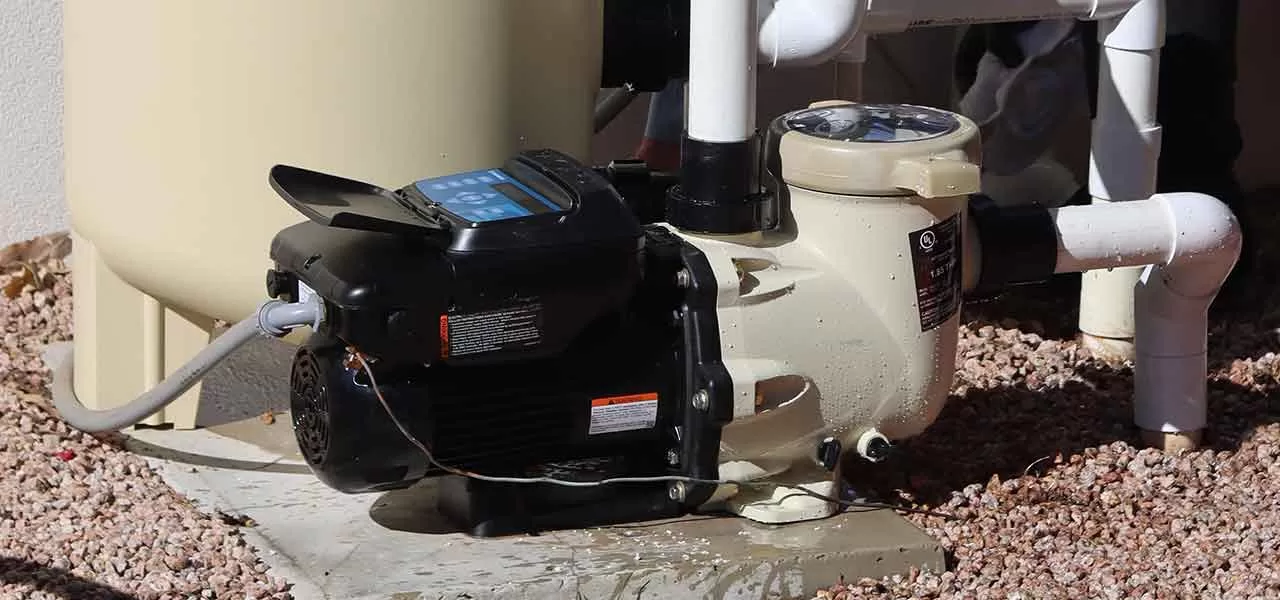

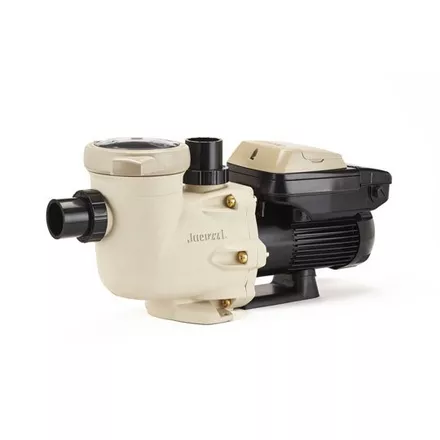

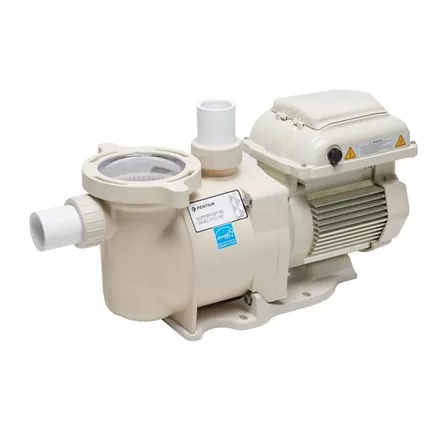
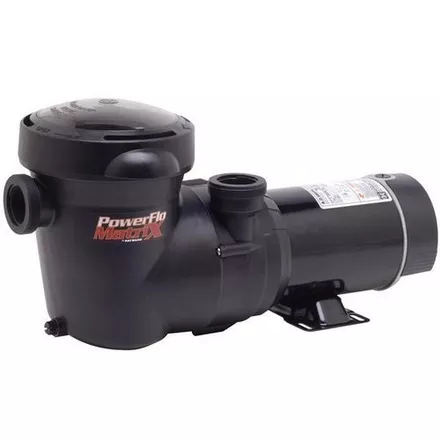
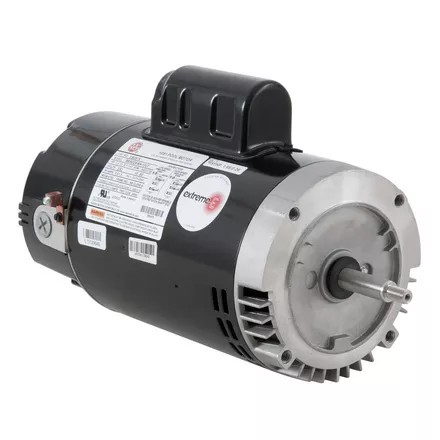
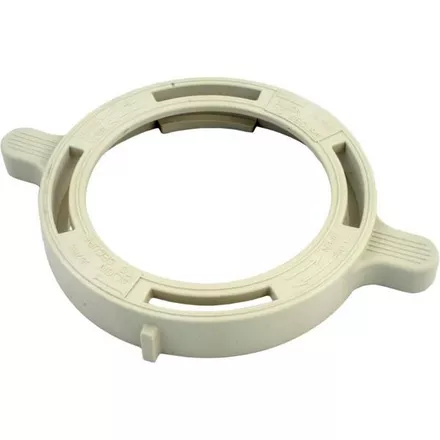

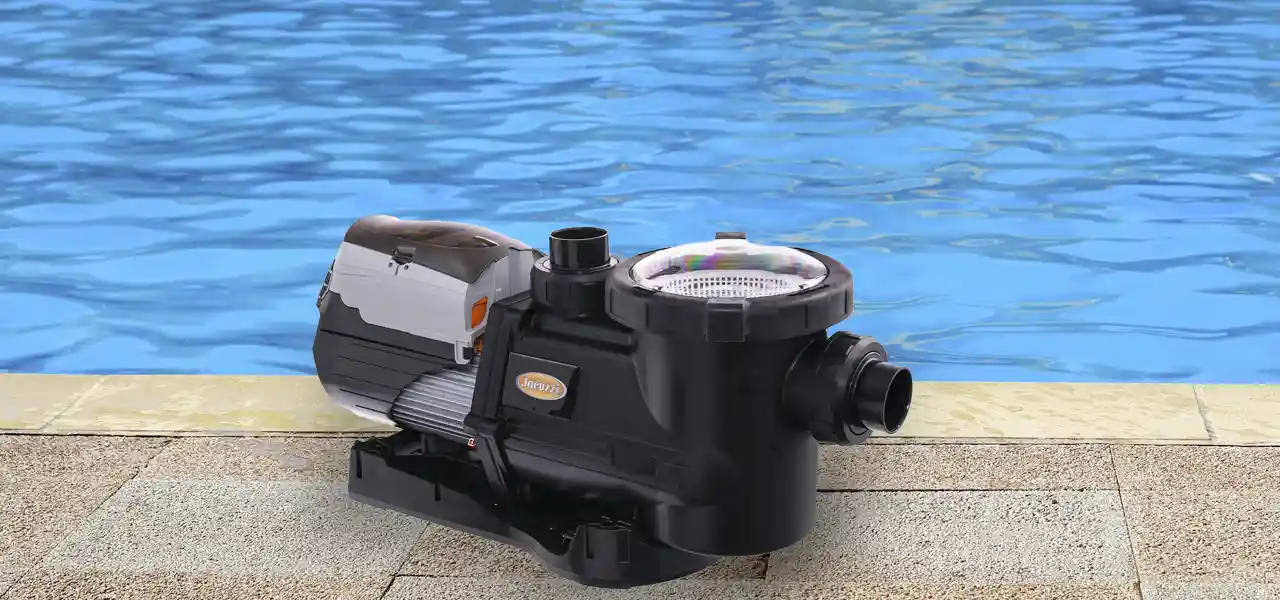
HI
I need to install a pump with less than 250mm clearance on the inlet side of the pump from the elbow.
What is your view on installing flex pipe in a loop to overcome the issues of having the elbow hard up against the inlet?
Hi Damon, 250 mm is almost 10″, which is OK, to curb the turbulence after the 90. Using a sweep elbow would be another way to calm the water. Or, using flex pipe in one big sweep is another good idea, no problems there.
Good morning, Today I was vacuuming the pool I noticed a change on the sound of pump. I turned it off then it wouldnt turn back on.Then I waited awhile it turned back on, water was flowing properly, then I noticed white smoke coming out. I turned it off immediately. What could the problem be.? I rent and my landlord doesn’t have the money to replace it. Can you give me suggestions on how to fix it and the cost. It’s a Pentair WF-23/011771 Thank you
Hi Lynn, perhaps the smoke came from a blown capacitor, which is a black cylinder in the rear of the motor. If it looks bulged, cracked, oily or smells like burnt wires, replace with the exact same MFD number printed on the side. Also check that the two switches in the rear of the motor are tight and aligned and wired tightly. Also check that incoming power wires are tight and not broken. If none of those things fixes it, it was probably a short in the motor, which is usually the end of the motor 🙁
Hello, I have an Krystal Clear sand filter/pump- 12 inch-
model# SF80110-2 with hydro aeration jet assembly where it returns water to pool. I am experiencing lower return flow after I installed a new connector without the my inner air jet valve piece and replaced with a adapter to be able to hook up a pool skim and to use “the circulator” The flow was fine when I installed the pool skim but after I tried the circulator for a few minutes I removed it and I noticed when I turned on my pump that evening the flow from the return is not what it was. I backwashed and rinsed and the pressure gauge is in the green normal area. i am wondering if the circulator reduced flow and did something to the pump/filter? The whole body of it screws in the connector. I will tell you what I all did so maybe it will help. I drained water below return. I closed the plunger valve and I closed the plunger valve to the outlet t joint and on the multi port valve I switched it to closed. I disconnect plunger valve and return inlet connector. I installed the new connector with the jet valve insert removed and the circulator adapter(threaded piece of pvc pipe)in its place. I released the air release on the skimmer pump tank and removed the lid and basket to clean. I replaced the lid and I opened up the plunger t valve and opened the plunger valve on return and switched mutli valve port from closed to filter and I closed the air valve on pump basket when water started to run out of it. I installed pool skim and used it for a few hours I then installed the circulator and used for a few minutes and removed it. That evening turned on pump and the flow was not as usual. My husband said it was because the jet valve insert was removed but it was flowing fine when I hooked up the pool skim. I guess I could hook back up the old connection with the jet valve and see if I have good flow but I do not want to drain all that water again to switch out. What do you think?
Hi Gaylene, the Circulator won’t work so well on Intex pools, that is a product for inground pools with much larger pumps. I think it may be restrictive, and perhaps your husband is right, it may need the Jet Valve in place to provide the proper back pressure and produce proper flow.
Hi there, my pool is currently shutdown for the winter and was properly closed and winterized. The other day the power in our area went out and by mistake my wife turned on the pool pump circuit breaker at the panel thinking that was the reason of the power failure. 3 days had passed before I realized the pump was running, I found it running at a very low humming sound, there was no indication of extreme heat when I placed my hand on the side of the housing. I immediately turned off the breaker and am now wondering if the pump is completely ruined. Any input and insight is greatly appreciated. Thanks
Hi Lou, I would open up the pump and pull out the pump basket and see if the basket or pump lid looks warped or heat damaged, if not, then so far so good! Next, replace the pump plugs and then carefully fill the pump pot with water, so as not to spill any water around the pump, and see if water drips out from the shaft seal, which will drip under the pump, at the point where the motor attaches to the pump. If not, so far so good! Then remove the plugs and let the pump drain out, since we may get more freezing nights before you open the pool. When you do open the pool, the threaded PVC fittings connected to the pump may have shrunk from the heat, if so, the pump would draw air into the pump around the intake fitting, or leak water around the outlet fitting. If so, you can use pool putty for a possibly semi-permanent repair to the intake fitting, or replace the fitting (or union). With the outlet fitting, if it leaks, putty won’t help, it would need replacement. The pump won’t be ruined, but you may need a new shaft seal, or new in/out fittings. Honest mistake, don’t be too upset with her. At least she is not afraid to flip a breaker, like my wife! 🙂
Hi,
Will a pool pump be damaged if it is always covered with a cover when it is operating?
Thank you.
Hi Stan, the downside would be the lack of full air flow. IF the pump has a slight breeze in the area, moving hot air up and away from the pump. A rain and sun shield is a good idea, but not at the sacrifice of air flow. And motors should never be wrapped tight, even if OFF all winter, for example, because the lack of air can contribute to condensation and rust.
are most pool pumps outdoor rated, and intended to be installed outside in the weather?
Hi, that’s true, all pool pumps are rated and certified to work outdoors, with ‘continuous duty’, or 24/7 if needed. They do require good ventilation, and protection from flooding.
HOW TO INSERT CHEMICALS (SALINE SYSTEM) SUCH AS PHOS FREE, STABILIZER, ACID, ETC., INTO POOL SO AS TO CAUSE LEAST DAMAGE TO PUMP? HAVE READ THAT INSERTION INTO FILTER MAY BE PROBLEMATIC. THANKS.
Hi Al, just about every chemical will instruct to add directly to the pool, by pouring around the edge or broadcasting over the surface. You never want to put chemicals into the skimmer, especially the more caustic chemicals like chlorine or acids. If a chemical label instructs to add to the skimmer (as a few do), follow those guidelines, but otherwise add directly to pool. Chlorinators and salt cells are another exception, they are installed after the filter (only) and always after any heater, and always ‘last on the line’.
I really appreciate your blog. I have a heyward pool pump (model sp3400vsp) for an inground pool reading “communication fail” check wiring between display and drive” I checked the everything is secure. I checked the timer and freeze guard, every thing working properly. Is there a part for the pump that needs replacing? If so can I order?
Hi, check page 23-24 of the owners manual to check the display comm power and drive comm power. Could be knicks on those tiny wires, or loose connection, dirt/insects, or something that is blocking power. May not need any parts. If your display is blank there are many steps in this Hayward Ecostar Troubleshooting Guide